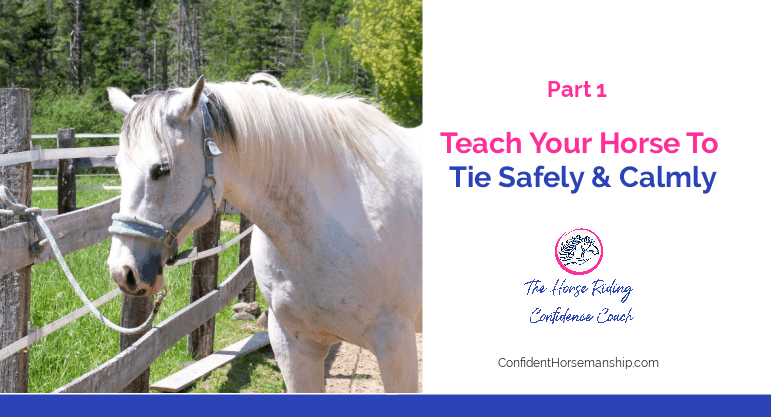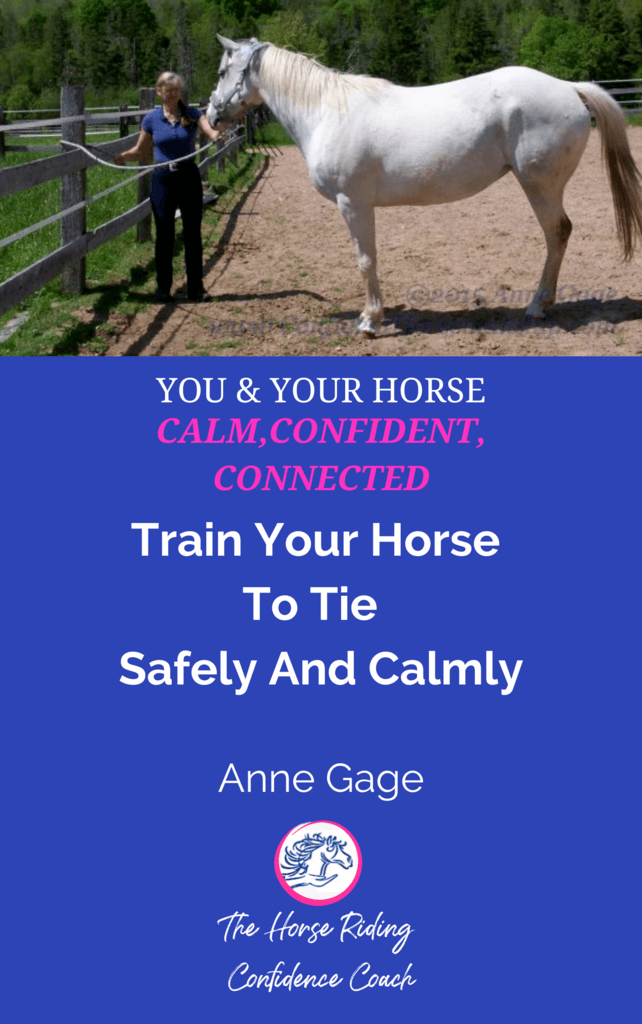
Tying a horse is such a common part of horsemanship that most people never give it a thought.
But if you’ve ever experienced or witnessed a horse panicking while tied to a hitching post or a trailer, you know how dangerous it can be.
The horse might have been standing quietly. Even seeming to be asleep.
And then seemingly out of nowhere, he explodes creating chaos!
And, creating a risk of injury to himself...
...as well as to the people and other horses around him.
Teaching your horse how to stand quietly and calmly while tied is an essential part of his training.
And for keeping both you and your horse safe.
Tying Your Horse Safely Means Not Triggering the Flight or Fight Response
Since horses’ primary defense is flight, it’s understandable that they have a very powerful and instinctive fear of being restrained in any way.
Training that uses strong restraints triggers fear - often causing the horse to “fight it out” triggers that flight/fight response.
Some people recommend teaching a horse to tie by tying him to something solid (like the so called “patience pole”) with a rope and halter that won't break.
Or even tying a rope around his barrel and back up through the halter.
These kinds of methods can cause some horses to panic so much that they cause serious injury to themselves.
Including damage to the cervical vertebrae, broken legs, or permanent nerve damage in the poll, neck or back.
If the horse flips over, the result can be broken withers or even death from a broken neck.
Even if he doesn’t injure himself, the horse learns only that “resistance is futile”.
That’s known as learned helplessness - a sense of powerlessness. Certainly not something you want in my equine partner, is it?
It is possible to teach your horse to tie safely while building his trust and helping him to over-ride his instinctive behaviour.
A word of warning: working with a horse that has learned to break away or panics when tied can be dangerous. Be honest about your own ability, skill level, and confidence. If you’re out of your depth then get help from an experienced trainer who doesn’t offer quick fixes, and will work with you and your horse together.
The steps for teaching your horse to tie safely are the same steps for teaching him to lead and stand quietly.
Follow these steps outlined below to teach your horse to tie calmly.
Steps To Teach Your Horse To Tie Calmly - Giving to Pressure
Before teaching your horse to tie safely, he must consistently (and with no resistance) give to light pressure.
That light pressure can be a:
- block you put on his halter asking him to lower his head, halt or back up
- a push sent towards his flank asking him to step forward
- a block to his chest asking him to not step forward.
Your horse should give to light pressure from all directions – left, right, forward, back-up, and down – consistently without resistance or pulling back.
Your horse’s frame of body reflects his frame of mind so begin with your horse in a calm frame with his:
- body straight (spine aligned nose to tail)
- poll level with or slightly lower than his withers
- feet square underneath him.
Tips for the giving to pressure exercise:
- Maintain supple contact on the lead rope.
- Keep yourself at a safe distance from your horse’s front feet in case he strikes or rears.
- Only apply gentle, steady pressure on the rope. Never jerk or pull.
- If your horse becomes unsettled or stressed, take the time to bring him back to a calm frame before continuing with the exercise.
Giving to Pressure Exercise
Make sure your horse is comfortable giving to blocking pressure in all directions with contact on your lead rope.
Holding the rope like a rein with knuckles facing up gives you more suppleness in your arm.
1. Stand beside your horse’s shoulder and face forwards.
Hold your lead rope about 4 inches below your horse’s chin and apply gentle, steady pressure straight down towards the ground.
Do not jerk or pull on the rope.
If he drops his head and remains calm, he is giving to downwards pressure on his poll.
2. Use even less pressure by stroking the rope from the clip towards your body.
3. Next, apply gentle, steady, and light pressure towards his chest.
4.As soon as he shifts his weight back or takes a step back, release the pressure, and reward him with a good scratch on the withers or a small food treat.
5. Repeat the exercise as above but take your rope to the right and to the left.
6. Stand about 2 feet in front of your horse and face towards him.
Apply gentle, steady forward pressure towards you.
If your horse offers no resistance and quietly steps forward keeping his neck level, he is giving to that forward pressure on his poll.
7. for the “try” and reward that.
The try is simply a movement in the right direction. It could be a tiny shift of weight or tipping his nose just a wee bit towards you.
8. Add a reward to tell your horse he is doing well. Give a small food treat or a good scratch on his withers as soon as he gives to the pressure.
Practice this exercise with your horse in different locations until he is consistently giving to gentle pressure without pulling back.
If he raises his head, pulls against the pressure or does not respond, then he is not ready to be tied safely.
When you’re ready for the next step, read Part 2 – Ready to Tie
The Bottom Line: When you help your horse feel calm and safe by removing physical and mental stress, your horse will be less likely to panic and will look to you for reassurance.
MINI COURSE
Learn How To Train Your Horse To Tie Calmly and Safely
Whether you're teaching your young horse or re-training a horse who is anxious when tied, in this mini course you'll discover how to:
- Reduce your horse's tension about being tied - without using force or fear.
- Safely introduce your young horse to being tied
- Re-train a horse who won't stand still, pulls back or even panics when tied
- Earn more trust from your horse so you can both feel more calm, confident and connected.
The course includes 6 videos and a PDF format eBook.

